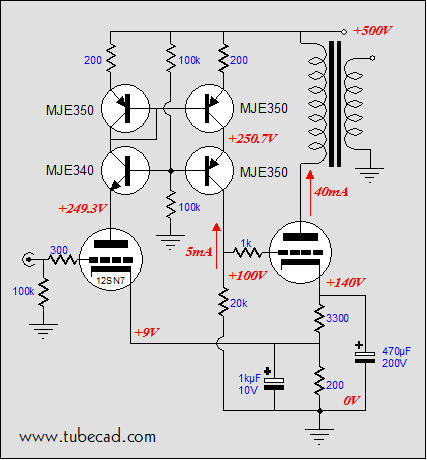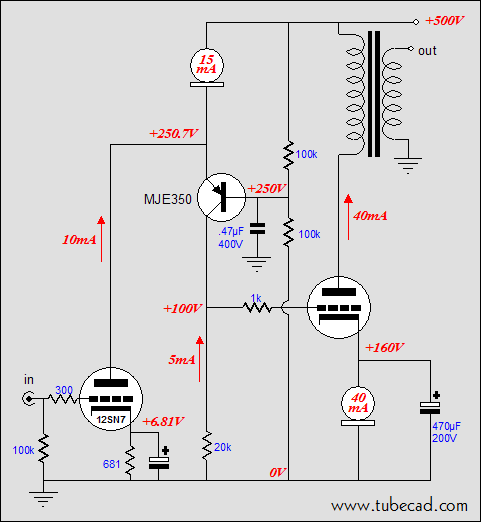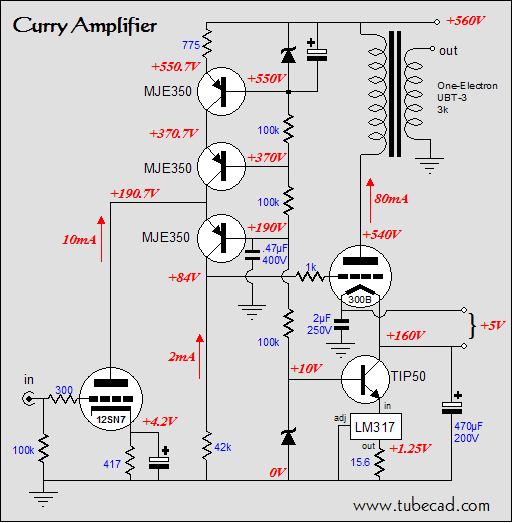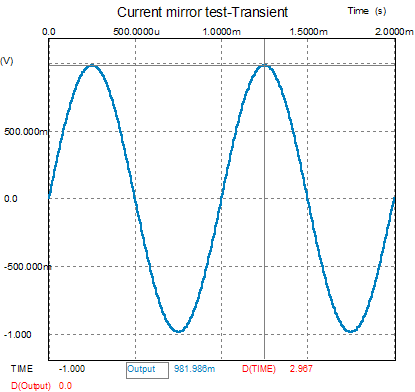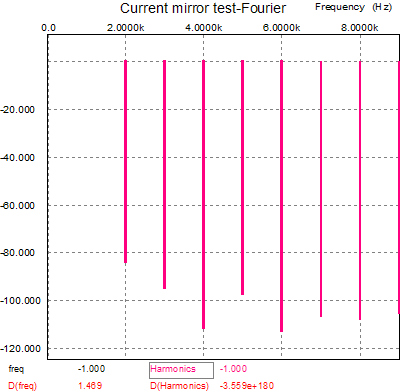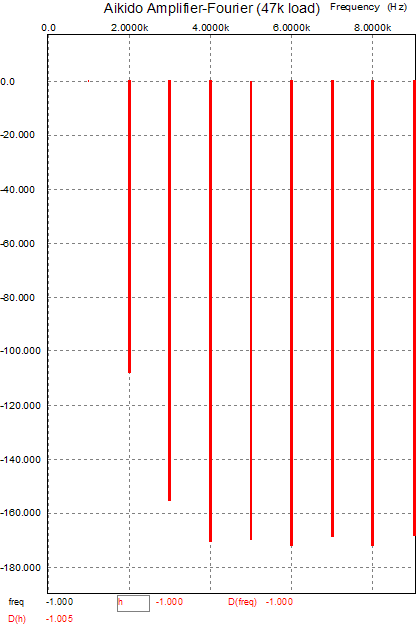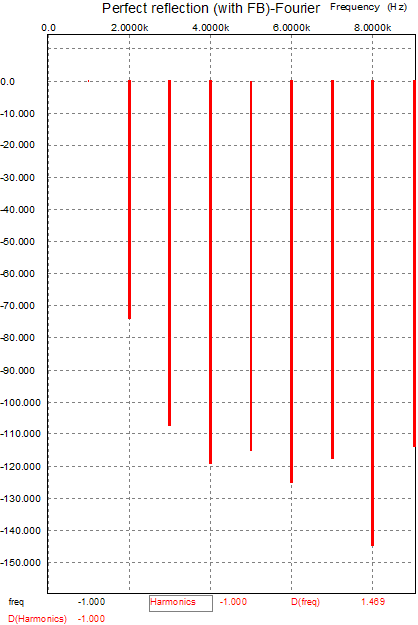| John Broskie's Guide to Tube Circuit Analysis & Design |
|
||||
05 January 2005 E-mail from Australia
Bart is referring to this current-mirror-based amplifier:
The answer is yes, the negative power supply can be eliminated, at the cost of greater heat dissipation, but not a smaller bypass capacitor. The cathode resistor is in parallel with the cathode's impedance, which equals (rp + Ra) / (mu + 1), where Ra equals the primary's reflected impedance. Thus, if the cathode resistor were replaced by a constant-current source, a capacitor would still be needed sufficiently large to shunt the lowest frequencies to ground.
Of course, a similar trick can be applied to the cascoded version of the amplifier:
Above is an idealized schematic; below is a fully fleshed out schematic. The Curry amplifier
This amplifier uses a 300B as the output tube and should put out 8 watts with less than 5% distortion. The LM317 is configured as a constant-current source, which automatically sets the 300B's idle current to 80mA. The current is set by dividing 1.25 by the desired current, which yields the LM317's adjustment resistor's value. The TIP50 is a high-voltage transistor that limits the voltage across the LM317 to 9 volts, so no heatsink will be needed with TO-220 packaged LM317s. The three MJE350s each see a 180-volt voltage difference between emitter and collector. No coupling capacitor is used, so some care is required in setting the 12SN7's idle current, as the CCS will starve the 42K load resistor, if the 12SN7 draws too much current; or, over-voltages the 42K load resistor, if the 12SN7 draws too little current. (A potentiometer in parallel with the 12SN7's cathode resistor might be a good idea.) Note how the 12SN7 (6SN7) draws five times as much current as flows through the 42k load resistor. The cascode action remains in effect, but this arrangement allows the triode to realize a much greater gain and run in a much more linear region. (If building a monoblock amplifier, the 12SN7 can be cascoded with itself, just to give the redundant triode something to do; or, it can be used to provide an additional gain stage or it could be used as a cathode follower. However, I would not doubled up the triodes as a single triode.) 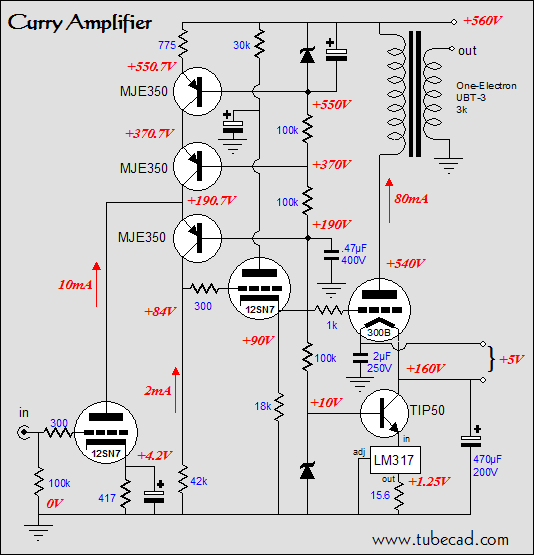
Since this amplifier might just get built, it needs a name: the Curry Amplifier. Those in the know, will know. How much would such an amplifier cost to build? My guess is about $400 per monoblock, depending on the 300B used (about $30 for all the parts other than the 300B and transformers—yes, including the 12SN7). If you have as much stuff in your part bins as I do, the cash outlay might be as low as $200 per channel. A monoblock power supply is easily created from a 400-0-400 volt (800V CT ) @ 200mA, such as Hammond P-T278X, whose rectified voltage (using silicon rectifiers) is easily 560VDC, but a PS choke can take care of excessive voltage. The 5VAC winding could be full-wave-bridge rectified to 5VDC or used in AC with two small in-series resistors to drop the voltage back dow to 5VAC, as the 1.2A draw from the 300B's filament will unload the 3A winding. The 6.3 winding can be easily voltage doubled to about 18 volts, which can then feed a 12-volt fixed regulator or a voltage dropping series resistor. Making a stereo amplifier will require separate filament power supplies for each channel. 04 January 2005 Reflections on perfect reflections The results were interesting. First of all, a current mirror based on the MJE350 (or any other transistor) does not perfectly mirror the current flowing into it, but it comes close. With the 200-ohm emitter resistors, 98% of the current is mirrored. For example, if 1mA of varying current goes in, 0.98mA of varying current comes out. The distortion with a 0.1mA varying current signal (equals 0.98 volts across the 10k resistor) is about 0.01%.
When using a transistor-based current mirror, I always match the transistors, believing it critical, besides my VOM holds a hfe test, which makes the matching painless. Well, using unmatched transistors, with one having twice the beta as the other, only slightly increased the distortion and reduced the current mirroring efficiency by less than one percent, so maybe I have been overly nervous. 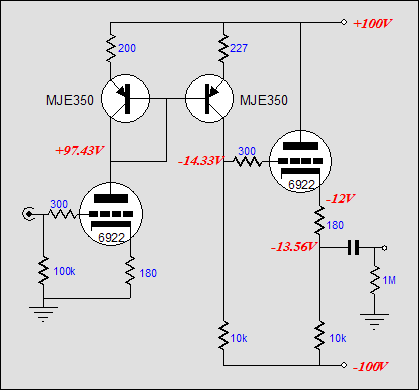
The entire amplifier (using 6922s and some tweaking) performs fairly well in simulation (real results may—and invariably do—vary). 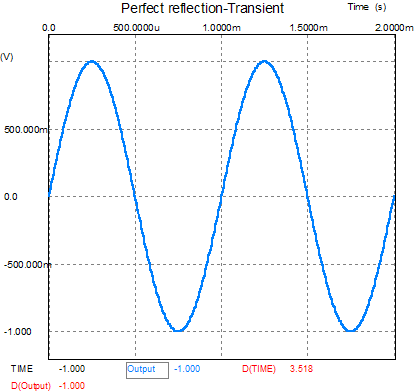 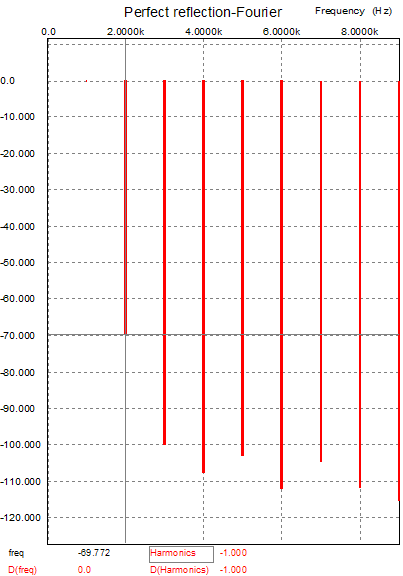 The PSRR figure is an impressive -50dB and the gain is a high 28 (+29dB). Compare the graph above with the Aikido amplifier's Fourier graph.
The winner is obvious in terms of distortion; both tie in output impedance; and the Aikido (using all 6922s) only has a gain 0f 16 (+24 dB). What if we swapped some of the current-mirror-based amplifier's gain for linearity? 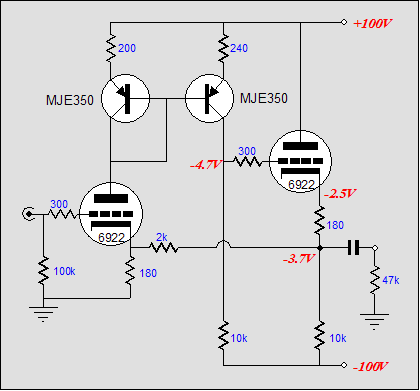
Since the output is in phase with the input, and since the amplifier puts out so much gain, a feedback loop is easily added and needed to bring down the gain to 8, which equals +18 dB (this more than enough, as +6 to +12 dB of gain is all that most line stages need).
Good enough for most, but the Aikido amplifier's low distortion is haunting. Cascoded current mirror 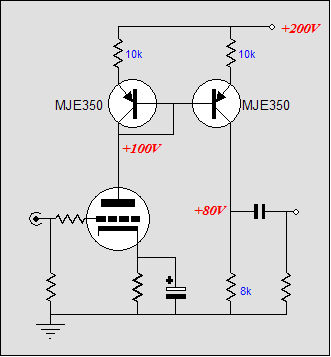
On the other hand, when the emitter resistors are low in value relative to the triode’s rp, say 100-200 ohms, then the Miller-Effect capacitance disappears and the gain climbs close to gmRa. 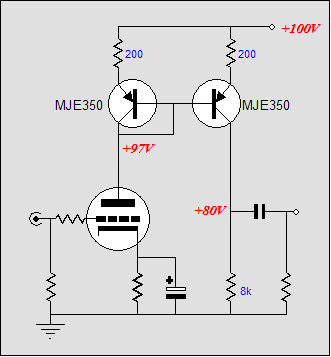
Now the question is What if we cascode the current mirror? 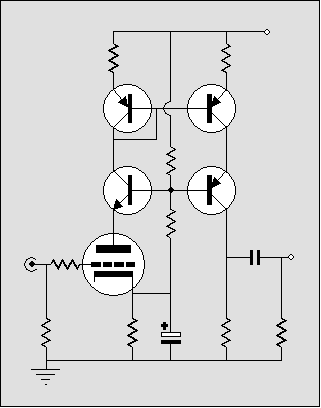
One advantage that immediately comes to mind is that we can now use low-noise, low-voltage transistors in the current mirror portion of the circuit. Second, we could use multiple PNP transistors in series to allow even high voltages to be used. Last, the cascoding would greatly improve the PSRR figure when used with a monopolar power supply, as the triode would not see any of the B+ noise on its plate. Since this topology does not invert the phase of the input signal, we can use the cathode as a negative input for applying feedback. 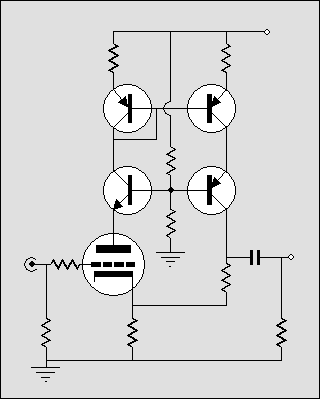
Still, the problem this topology faces is that it does not improve upon a grounded-cathode amplifier’s PSRR. Inverting the cascode and adding a constant-current source will take care of the PSRR troubles, as the B+ noise cannot make across the constant-current source. 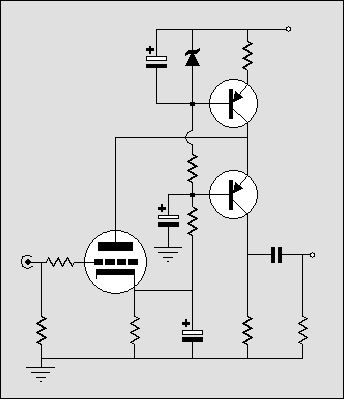
A truly low-noise cascode offers some real advantages for preamps and line amplifiers. One use for this circuit that comes to mind is that of an input stage in a single-ended amplifier. 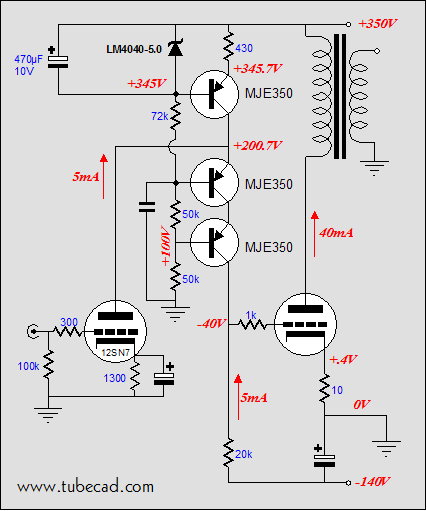
Two MJE350s are used in the cascode portion of the circuit, decreasing the likelihood that the high voltages with the amplifier will kill one of the fragile transistors. The output tube’s grid (the tube could be a 300B or triode-connected 6550) directly coupled with the input stage. Such an does eliminate the need from a coupling capacitor and its associated headaches, but it also introduces a real safety issue: What happens at startup and what happens if the input tube is removed from its socket? At startup, the 470µF bypass capacitor across the IC voltage reference saves the day, as it must slowly charge up to the reference’s voltage, which will allow the input and output tubes to heat up enough to start conducting. Removing the input tube presents a much greater danger, as the constant-current source will eventually come up to its full 10mA of current draw, which against the 10k resistor will develop +60 volts at the output tube’s grid (not a good idea). One work around would be to bridge the grid to ground via a reverse biased diode. The diode would not conduct as long as the grid was negative relative to ground (+0.7 volts to be more precise), although this might make for some hard clipping. A better workaround might be to replace the input tube’s cathode resistor with a relay’s winding. Now, until the first tube is conducting enough to actuate the relay, the output tube’s grid could be shorted to the negative power supply rail. Interestingly, the cascoded constant-current source did not suffer from this problem, as the input stage defines the current flow, not a constant-current source. In other words, without an input tube, there’s no conduction and the output tube’s grid is pinned to the negative power supply rail. Much safer. But there’s a problem hidden here as well. 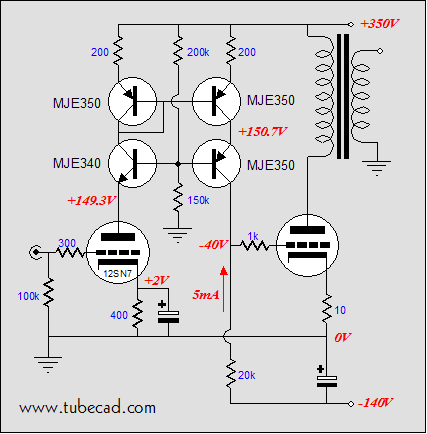 No tube is perfectly linear. All triodes are easier to turn on than they are to turn off. This make for a strong 2nd harmonic distortion component. 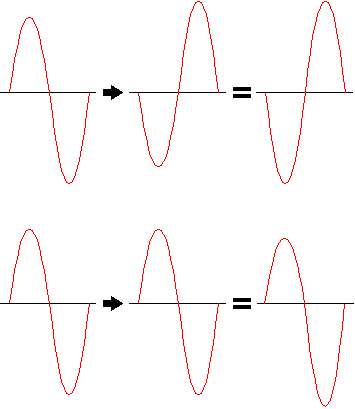
But if two triodes are cascaded, wherein one turns on as the other turns off, much of the nonlinearity vanishes. However, in the opposite case, wherein one turns on as the other turns on, the nonlinearity compounds, making for much more distortion. Well, in the current mirror arrangement, the phase is preserved, which means that the input stage works in the same current phase as the output triode, compounding the nonlinearity; whereas the inverted cascode stage inverts the input signal, which means that the input stage works in the opposite current phase as the output triode, reducing the nonlinearity. (Paradoxically enough, using a more linear amplifier, like the Aikido amplifier, can yield more distortion at the loudspeaker because it is so linear and it can't pre-bend the signal for the output tube bend in the opposite direction. Absolutes make little sense in complex mixes.) So you must chose safety or sound. Or, why not add a coupling capacitor to the inverted-cascode-stage-based amplifier and get both safety and good sound? Well, here’s one reason against that move: the current-mirror-based amplifier allows for an easy DC feedback loop to be applied from input stage to output stage, automatically correcting the output’s idle current. 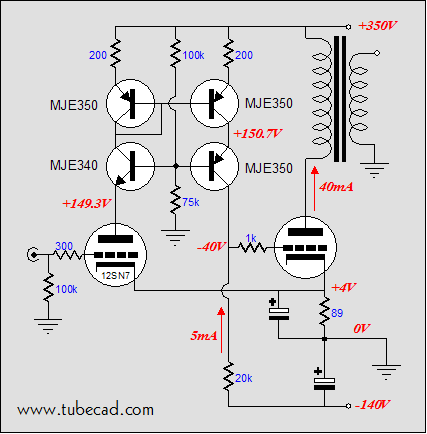
If the output tube draws too much current, the input tube conducts less, which decreases the voltage across the load resistor, which in turn decreases the output tube’s conduction. The opposite situation is easy to imagine. //JRB |
|
|||
| www.tubecad.com Copyright © 1999-2005 GlassWare All Rights Reserved |
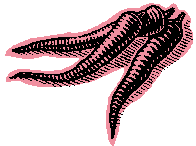 Curry Amplifier
Curry Amplifier 